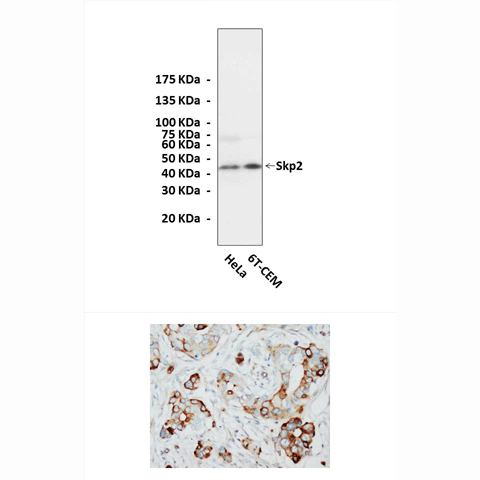Anti-SHH: Rabbit Sonic Hedgehog Antibody |
 |
BACKGROUND The hedgehog (Hh) signaling pathway is crucial in the development of all known animals. In the embryo, it regulates morphogenesis of a variety of tissues and organs, in the adult, it controls stem cell proliferation. There are three human Hh proteins; Sonic hedgehog (Shh), Desert hedgehog (Dhh) and Indian hedgehog (Ihh). Each is expressed at different times of development and in specific cell types and they are tightly controlled by highly complex, yet divergent transcriptional enhancers. Hh protein release and diffusion is controlled by various proteins including Skinny hedgehog (Sit), Dispatched (Disp), Tout-velu (Ttv) and Hedgehog-interacting protein (Hip). Hh proteins bind to the twelve transmembrane domain protein, Patched (Ptc). In the absence of Hh proteins, Ptc catalytically inhibits Smo. Hh-Ptc binding results in loss of Ptc activity and activation of Smo, which transduces the Hh signal to the cytoplasm. This leads to the activation of the Ci/GLI family of transcription factors, through complex interactions of Costal2 (Cos2), Fused (Fu) and Suppressor of fu [Su(fu)]. Furthermore, PKA, CK1, GSK-3 and Slimb modulate this signal transduction pathway. Abberant activation of the Hh pathway has been linked to multiple types of human cancer, particularly basal cell carcinoma. Disruption of Hh signaling during embryonic development, either through congenital mutation or maternal teratogen consumption, can lead to severe developmental disorders such as holoprosencephaly.1
SHH is instrumental in patterning the early embryo. SHH binds to the patched (PTC) receptor, which functions in association with smoothened (SMO), to activate the transcription of target genes. In the absence of SHH, PTC represses the constitutive signaling activity of SMO. SHH also regulates another target, the gli oncogene. It has been implicated as the key inductive signal in patterning of the ventral neural tube, the anterior-posterior limb axis, and the ventral somites. Of three human proteins showing sequence and functional similarity to the sonic hedgehog protein of Drosophila, SHH is the most similar. SHH protein is made as a precursor that is autocatalytically cleaved; the N-terminal portion is soluble and contains the signaling activity while the C-terminal portion is involved in precursor processing. More importantly, the C-terminal product covalently attaches a cholesterol moiety to the N-terminal product, restricting the N-terminal product to the cell surface and preventing it from freely diffusing throughout the developing embryo.2 Defects in SHH or in its signaling pathway are a cause of holoprosencephaly (HPE), a disorder in which the developing forebrain fails to correctly separate into right and left hemispheres. HPE is manifested by facial deformities. It is also thought that mutations in SHH gene or in its signaling pathway may be responsible for VACTERL syndrome, which is characterized by vertebral defects, anal atresia, tracheoesophageal fistula with esophageal atresia, radial and renal dysplasia, cardiac anomalies, and limb abnormalities. Additionally, mutations in a long range enhancer located approximately 1 megabase upstream of SHH gene disrupt limb patterning and can result in preaxial polydactyly.3
SHH is instrumental in patterning the early embryo. SHH binds to the patched (PTC) receptor, which functions in association with smoothened (SMO), to activate the transcription of target genes. In the absence of SHH, PTC represses the constitutive signaling activity of SMO. SHH also regulates another target, the gli oncogene. It has been implicated as the key inductive signal in patterning of the ventral neural tube, the anterior-posterior limb axis, and the ventral somites. Of three human proteins showing sequence and functional similarity to the sonic hedgehog protein of Drosophila, SHH is the most similar. SHH protein is made as a precursor that is autocatalytically cleaved; the N-terminal portion is soluble and contains the signaling activity while the C-terminal portion is involved in precursor processing. More importantly, the C-terminal product covalently attaches a cholesterol moiety to the N-terminal product, restricting the N-terminal product to the cell surface and preventing it from freely diffusing throughout the developing embryo.2 Defects in SHH or in its signaling pathway are a cause of holoprosencephaly (HPE), a disorder in which the developing forebrain fails to correctly separate into right and left hemispheres. HPE is manifested by facial deformities. It is also thought that mutations in SHH gene or in its signaling pathway may be responsible for VACTERL syndrome, which is characterized by vertebral defects, anal atresia, tracheoesophageal fistula with esophageal atresia, radial and renal dysplasia, cardiac anomalies, and limb abnormalities. Additionally, mutations in a long range enhancer located approximately 1 megabase upstream of SHH gene disrupt limb patterning and can result in preaxial polydactyly.3
REFERENCES
1. Tanabe, A. et al: J. Clin. Endocrinol. Metab. 92:1145-54, 2007
2. Hotta, K. et al: J. Endocrinol. 202:111-21, 2009
3. Stein, C.M. et al: BMC Genet 4:S99–S103, 2003
2. Hotta, K. et al: J. Endocrinol. 202:111-21, 2009
3. Stein, C.M. et al: BMC Genet 4:S99–S103, 2003
Products are for research use only. They are not intended for human, animal, or diagnostic applications.
Параметры
Cat.No.: | CA1072 |
Antigen: | Short peptide from human SHH sequence. |
Isotype: | Rabbit IgG |
Species & predicted species cross- reactivity ( ): | Human, Rat |
Applications & Suggested starting dilutions:* | WB 1:1000 IP n/d IHC 1:50 - 1:200 ICC n/d FACS n/d |
Predicted Molecular Weight of protein: | 21 kDa |
Specificity/Sensitivity: | Detects endogenous levels of SHH proteins without cross-reactivity with other related proteins. |
Storage: | Store at -20°C, 4°C for frequent use. Avoid repeated freeze-thaw cycles. |
*Optimal working dilutions must be determined by end user.
Документы
Информация представлена исключительно в ознакомительных целях и ни при каких условиях не является публичной офертой








